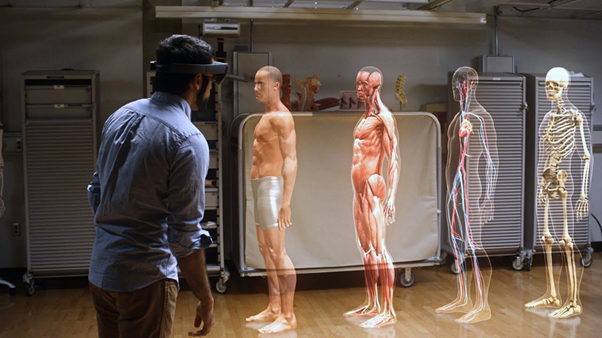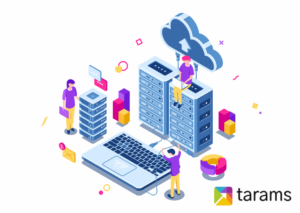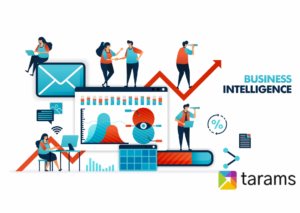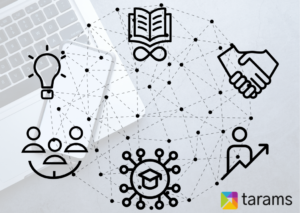The Untold Secret To Mastering The Future of AI Education: current barriers, resolutions & the future!
The role Artificial Intelligence in education landscape and Immersive technologies in learning space have propelled impactful transformations across all industries such as finance, healthcare, chatbots, art, manufacturing, IT, innovation and many more. Likely, its penetration, especially in education realm, has grown by leaps & bounds.
With a skyrocketing success in achieving remarkable literacy rate on the planet, the education space is facing new barriers and challenges when it comes to raising the bars higher and taking the current education to a whole new level.
Now that, the AI in the education industry is well equipped and advanced with digital technology, still, we believe the way we teach, however, has to CHANGE.
No matter if it’s a physical classroom or an e-learning session; the contemporary learning methodology is still archaic. We arbitrarily group learners based on their age or preference and make them listen to a trainer and sit back and expect that the involved parties are competent enough to keep the learners engaged through a static educational curriculum.
Indeed, the current methodology works, but up to an extent. For a fact, the trainers or tutors are overloaded with work such as building curriculum, imparting, planning assignment, grading, etc. Thus, it’s next to impossible for them to give hundreds of students personalized attention.

tarams elearning
While a tutor is busy with all this, students remain under consistent pressure to secure grades in a stipulated time frame.
Despite being equipped with digital technologies, the education system is crippled when it comes to catering individualized learning & self-development.
Today, students don’t know why they are learning the lessons that they are learning, it makes matters worse and a big question in the face of the student’s personal ambition. However, AI in education plays a game-changing role in making the system more effective but still numerous Edtechs are unaware of the role of artificial intelligence in education.
So what’s the solution here? What could make the learning more exciting, fun & productive?
Let us rundown on three key pillars- Individualized Learning, Experimental Learning & Mastery Learning that can make the learning ecosystem more powerful, however, the theories are not new by any means but still education providers are struggling to incorporate the same.
Individualized Learning: the need of the hour!
It’s a way to offer instructions based on interest, aspirations, weaknesses, and background of individual learners. It caters to an intuitive learning where the learning experience best fits into an individual and helps you get the most out of each session.
The True Potential of Individualized Learning is still unfulfilled- Here’s why?
So, as numerous theories substantiate to the fact that Individualized Learning is the need of the hour. In fact, the true potential of Individualized Learning is still unfulfilled.Even if you hire dozens of specialized instructors to pay individual attention, the challenge still extends i.e. how to collect and process personal student data in large scales to create actionable insights.

tarams elearning
Individualized Learning is all about non-linear curriculum and embracing student differences, this is where contemporary digital learning solutions and methodologies are losing value with each passing day.
Kudos to advanced technologies that helps providers to bridge the chasm when it comes to Individualized Learning, but before we dive deep into that, let’s explore the second pillar i.e. Mastery Learning.
Mastery Learning: key to Intuitive Learning & self-development!
Mastery Learning is a way to offer instructions that determines a level of performances that all learners must master before moving to the next module or unit. It is impactful when learning maths, where past lessons are necessary to understand the next lessons. A learner will only be allowed to move to the next lesson when they have mastered in all the fundamentals that precede it.
In today’s education platforms, if you secure 70% of a subject, you are entitled to move further- that’s general knowledge, not mastery. The grading mechanism fails to provide the exact performance feedback of a student and provider.
Thus, the learning needs remain unattended by the system they are leveraging.

tarams elearning
Why providers fear to deploy mastery learning?
Learners are pressured to rush through the semesters without understanding them and eventually, all those subjects become so unintelligible over the years that create broad knowledge gaps that lead to loss of intuition.
Mastery learning can invade all such issues with its in-depth individualized and personal approach. Here, a student won’t be allowed unless and until they don’t display mastery in a specific subject.
Though it’s a strong theory but still, providers are resilient to implement the concept. Due to hefty financial resources involved providers fear to deploy it realistically at large scale.
However, we will see that how AI will play a crucial role in thrashing such challenges but until then let’s understand the third pillar i.e. experimental learning.
Experimental Learning
“Learning by doing”is a primitive formula to grasp things really fast. Experimental learning helps you to understand from experience. It engages most of your senses, improves critical thinking, creates a context for memorizing and builds social-emotional skills.

tarams elearning
It creates curiosity to understand things more deeply; students consider making mistakes as a part of learning process.
Today’s education providers certainly try to implement it and adopt the model of homework to ensure that students do it by themselves.
But surveys reveal that homework is uninspiring and does not involve the senses rather makes the student more isolated.
Experimental learning: it’s a myth, here’s why?
These days, providers very well understand that revamping the legacy course will be a big design challenge when it comes to teaching subjects like maths, history or biology in whole new way. Since ages, we have been acquainted with books & blackboards, so do we go ahead in engaging all senses, keeping the learning social and active, attaining the learning goals and keeping the cost low?
It’s a big question, but read on as you will get to see the resolutions that AI has to offer before we conclude.
Now that we have identified the problems and our ultimate learning goals, let’s have a sneak peek on top 3 futuristic technologies can not only address the above challenges but can actually facelift the entire educational landscape.
Immersive technology: doors to the new world of education!
Immersive technology in education is the new way of innovation in the learning methodologies.
Technologies such as virtual reality empower a student to interact with the digital world and conceive realization of dwelling within a virtual world.
With Oculus Rift getting hype, providers have now started believing that it’s no more about just gaming. Rather, it’s a new world where you can explore new ways to interact and display information in the real world as if it’s actually there.
Microsoft HoloLens is another great example that interprets your environment — it identifies where your furniture is, your walls, and everything else, and uses that information to blend the physical and digital world into the reality perception.
Education providers can create real-world experiences at relatively low cost- be it a monument, experience the surface of the moon or the wreck of the Titanic. For education, this could be everything- a new beginning.
VR in education has taken its best foot forward in redefining education. It will take you through the human body in person not forcing you to learn from illustrations.
Recently, a start-up is developing an advanced learning platform that allows you to visualize human body holographic & 3D format.

tarams elearning
It’s a new way where students can apprehend concepts as characters, tests and exercises can be embedded as part of the story as hurdle and students will set free to explore and immerse themselves in the topics that are learning.This is where VR and artificial intelligence in the education industry is getting prominance with each passing day.
Hence, we can achieve our core education goals, immersive learning platforms allow you to learn socially & visually that is emotionally engaging and interactive that remains in your brain as long-lasting memory.
Learning analytics in education: blend BI with sentiments!
Today, headsets have become one of the primary tools to learn in an immersive environment and the good news is that headsets can be tracked. It helps you to understand what a learner is viewing at, for how long, what are they choosing to view and even ignore.
Image source; InstaVR
tarams elearning
Analytics platform displaying which areas users look at the most throughout a VR experience
Pupil tracking: the revolution in learning analytics!
You all might know that pupils expand on subconscious attraction but for a fact, it’s much more to that. The pupil expansion is also sensitive to emotional engagement and mental stress.
As per a survey, it was found that pupils expand proportionately with the difficulty ascending in a task. The variation in pupil can determine the level of difficulty in perception.

tarams elearning
Such a phenomenon can help education providers to gain a deep understanding of a learner’s psychology. It empowers them to create absolutely accurate student profiles to develop the right course that accurately resonates to a learner’s challenge.
It helps you to understand the relationship of a student with a respective course up to subconscious degree. Moreover, it can render exams and modules that best-fit to the ability of perception of a student.
Pupil analytics can be a revolution in digital learning platform that truly understands you as a student. It’s an immersive technology that blends with AI in education to automate mastery and individualized learning.
So how far, AI can take education? Will AI be your future teacher?
AI teachers: your future educator!
Let’s take our imagination further and see how the education world will look like with convergence with other advanced technologies.
With the smartphones being ubiquitous in the market, tools such as Amazon Echo, Google Siri, Assistant have become an integral part in daily lives. These tools help humans to have found intuitive ways to get things done. Here’s where we see voice recognition and text-to-speech technologies gaining ground with each passing day.
AI in education coincides with these immersive technologies will give physical appearance to AI assistants, chatbots etc. The technology will give these virtual assistants a body and an expressive face.

Image source: https://medium.com/futurepi/
tarams elearning
The day is not far when AI assistants will understand us deeply more then we understand ourselves. Going back, to our previous discussion about analytics, and capacity grasp student’s intellectual and emotions with the conjunction with AI, it’s apparent that AI teachers are the next potential recruits in the education industry.
You can spend hours with your AI teacher to gain mastery & experimental learning by great building projects together.
The burning news of Humanoid Robot Sophia gaining Saudi Arabia citizenship substantiates to the fact we are on the verge of a new world of education, where the concept of AI teacher will be no more a myth but a living fact. It’s quite apparent that role of artificial intelligence in education will take leaps and bounds and will create new wave of learning via AI in education industry.
UN deputy secretary general Amina having a dialogue with Sophia asking about her experience in gaining Saudi Arabia citizenship
Readers, the above innovations are just the tip of the iceberg, when it comes to the convergence of contemporary immersive technologies and AI in education space, possibilities are simply limitless.
Education is an endless ocean, and as an education provider or a learner, it depends on how you want to explore it to get the most out of your learning and development investment.
If you are a learner, then simply pull your socks up, as the next generation education platforms will have everything that will redefine your learning experience. Thus, it’s time to only learn what you want that too at its best.
However, with such advancements, Edtech will get numerous opportunities to educate learners in more interactive and productive ways. The future education market is going to be big and competitive.
Hence, if you are an Edtech and yet to make your roadmap to converge with the upcoming technology, it’s never too late, get started now before your competitor does it.
If the article resonates with your findings and learning roadmap and you are an educator, publisher, technologist or corporate interested to explore these challenges and resolutions, please contact Tarams, let’s do it together.
At Tarams, we help you design state-of-the-art digital learning platforms that accurately measure and collaborate learning programs giving you an extraordinary, intuitive and immersive experience.




